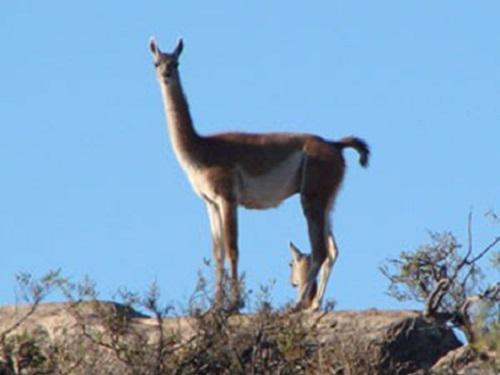Andrés Rey
Livestock competition, habitat degradation and poaching have been historic causes of decline of South American native wild guanaco populations. The main aim of our project is to evaluate if current declining guanaco abundance and distribution is being influenced by recent exotic red deer expansion in North-western Patagonia.

Adult guanaco (Lama guanicoe). Photo by Andrés Rey.
During the last century livestock competition, habitat degradation and poaching have caused a dramatic decline on wild guanaco (Lama guanicoe) populations. Guanaco, still the most abundant South American ungulate, reaching only 40% of its previous range and 2% of its original abundance. At present 90% of the currently remaining guanacos (500,000 individuals) inhabit Patagonia where they are persecuted by farmers for diminishing resources for their sheep.
In the last decades sheep farming has been decaying due to a fall in the wool trade price. However, guanacos do not show a clear recovery in North-western Patagonia and some populations have even continued declining and became ecologically extinct. One of the possible hypotheses about why guanacos still continue declining is that guanacos are now negatively influenced by red deer (Cervus elaphus); an invasive species introduced in the early 1900s that currently inhabit more than 50,000 km2 and reaches 100,000 individuals. The aim of this project is to evaluate if current guanaco abundance and distribution in North-western Patagonia is being influenced by red deer.
Guanacos and sheep compete for food resources so, if red deer also have a negative impact on guanaco, we expect that local densities of guanacos will be inversely related to the density of both exotic ungulates when they coexist. We will work in independent guanaco and red deer suitable study sites in a gradient from low to high density of exotic ungulates in sheep ranches. Fieldwork will be carried out seasonally in each study site. We will evaluate site suitability as availability of preferred food items for each species. Simultaneously we will estimate ungulate density by line transects methods.
To study potential negative interactions from red deer to guanacos and underlying mechanisms will contribute to develop conservation strategies for the guanaco, their natural habitat and other co-existing native species. To know current abundances and mechanisms of interaction will allow us to predict the most susceptible areas of red deer invasion and, in a scenario of red deer negative interaction on guanaco, the most threatened guanaco populations. To understand the interactions among guanacos, livestock and red deer could also contribute to change landowner’s historic neutral/positive opinion towards red deer, and other alien species in Patagonia. This change of opinion will contribute to engage local stakeholders in controlling red deer (and other exotics species) expansion and abundance, preventing the invasion of new sites and diminishing pressure on native species.